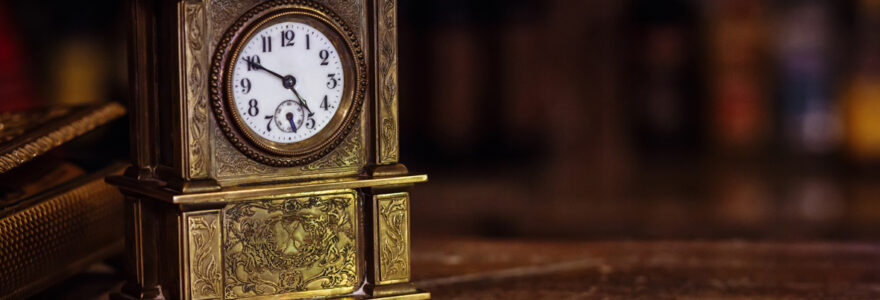Peering into the world of timekeeping can reveal a mesmerizing array of clocks, each with their own unique charm and history. Delving deeper, timepieces can be classified into various categories, two of the most popular being vintage and antique. Distinguishing between these two types can often cause confusion, as both embody elements of past eras. However, subtle differences exist and understanding these can significantly enhance appreciation for these timeless treasures. This piece aims to unravel the nuances between vintage and antique clocks, highlighting the unique characteristics, appeal, and value of each.
Deciphering the Distinction between Vintage and Antique Clocks
Understanding the distinction between antique and vintage clocks requires a deep dive into the annals of timekeeping history. The term 'antique' generally refers to items over 100 years old, representing a bygone era, while 'vintage' signifies something less than a century old but not in current production. This differentiation is not merely about age; it also involves the design, craftsmanship, and historical significance of the timepiece.
Antique clocks, belonging to periods predating the 20th century, often exhibit a higher degree of craftsmanship and intricacy. They are typically handcrafted, each carrying a unique story from its time. Conversely, vintage clocks, although younger, captivate with their retro designs and mechanization, embodying the spirit of their respective periods.
Estimating the age of a clock might seem daunting at first. Subtle clues lie in the clock's style, construction materials, and maker's mark. A checklist encompassing these key elements assists in this estimation process. Advice from experts, coupled with resources from educational sites and professional organizations, further enriches this understanding.
Maintaining these old timepieces requires special attention. A comprehensive maintenance guide can assist owners in preserving their cherished clocks. This includes tips on cleaning, oiling, and where to seek professional help if needed.
An infographic guide serves as a vivid visual journey through different styles and periods of vintage and antique clocks. It offers a quick, easy-to-understand reference for enthusiasts and collectors alike.
Whether antique or vintage, these clocks carry with them a piece of history, a slice of time, frozen forever in their ticking hands. Appreciating their beauty and value enriches not just a collection, but also our understanding of time itself.
Characteristics of Antique Clocks: More Than a Century of Time
Antique clocks, with their intricate designs and rich history, have captivated the fascination of many for years. Their age, quality, and craftsmanship significantly define these timeless pieces. The difference between vintage and antique clocks lies primarily in the age, with antiques being at least a century old.
Significance of Age in Defining Antique Clocks
Many consider age as the most defining characteristic of antique clocks. Items at least a hundred years old, they not only tell time but also narrate the world's history. Their value increases over the years, making them cherished possessions.
Art and Craftsmanship: Unique Styles of Antique Clocks
The designs and styles of antique clocks are a testament to the artistic skills of clockmakers. Each piece mirrors a specific time period, reflecting the changing trends and advancements in clockmaking over the years.
Material and Quality: Key Aspects of Antique Clocks
The materials used and their quality are crucial indicators of an antique clock's worth. Earlier clockmakers meticulously selected high-quality materials and employed intricate craftsmanship, resulting in long-lasting, durable pieces.
Exploring the Appeal of Vintage Clocks: A Retro Look with History
Within the realm of decorative objects, vintage and antique clocks hold a unique position. Antique clocks, often considered items more than a century old, encapsulate a rich historical narrative, while vintage clocks, usually dated from the 20s to the 80s, reflect past styles and art movements. Furnishing a home with a vintage clock not only adds a retro look but also breathes life into the history of that period. Choosing the right clock to complement various interior styles presents an exciting challenge. A vintage mantel clock, for instance, can balance modern and traditional styles, creating a beautiful contrast. Similarly, a vintage wall clock can enhance the character of a room, serving as a focal point. These timeless items, desired by collectors worldwide, add a layer of sophistication and elegance to any space.The history of vintage clocks is fascinating. Each era produced unique clocks, reflecting the prevailing style and art of the time. From the geometric designs of the Art Deco period to the minimalist style of the Mid-Century Modern era, each vintage clock tells its own story.Maintaining these historical objects is vital for their longevity. Regular cleaning, precise adjustments, and professional servicing can ensure these clocks continue to operate accurately and maintain their value. Expert evaluation can provide an accurate appraisal of a vintage clock's worth, offering peace of mind to collectors and enthusiasts alike.
Evaluating the Value: Factors Influencing Price of Antique and Vintage Clocks
Understanding the value of antique and vintage clocks can be a challenge. This comprehensive guide aims to assist both collectors and buyers in recognizing the key factors that determine the price of these collectable timepieces. Several factors need to be considered, from the overall condition of the piece to its rarity, quality, and age. All these elements play a significant role in the final valuation of vintage and antique clocks.
First and foremost, the condition of the clock significantly impacts its value. A well-preserved piece, with its original components intact, is likely to fetch a higher price. On the other hand, a rare clock, even if in less-than-perfect condition, might still command a high price due to its scarcity. The quality of the clock, which can be evaluated based on its craftsmanship, functionality, and aesthetic appeal, equally influences its market price.
